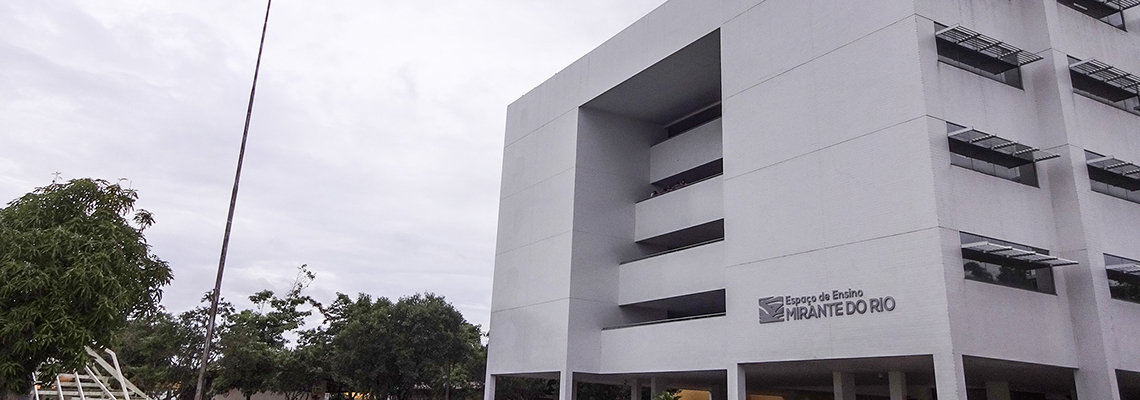1. Mandatory disciplines
Common to areas of concentration
Didactic Research Seminars (2 Credit Units, 30 Credit Hours)
Syllabus: Conferences and lectures by local experts and guests, as well as graduate student seminars.
Area of Concentration: Physical Chemistry
Advanced Physical Chemistry (4 Credit Units, 60 Credit Hours)
Syllabus: Chemical thermodynamics: calorimetry, entropy, phase balance, chemical balance. Statistical thermodynamics: Boltzmann distribution, molecular and canonical partition function, calculations of thermodynamic quantities from spectroscopic data. Chemical kinetics: reaction rate, homogeneous catalysis, heterogeneous catalysis, adsorption isotherms, reaction mechanisms.
Area of Concentration: Analytical Chemistry
Advanced Analytical Chemistry (4 Credit Units, 60 Credit Hours)
Syllabus: Statistics applied to Analytical Chemistry. Chemical equilibrium in ideal and non-ideal systems. Mathematical methods used in calculating equilibrium. Graphical representation of the chemical balance. Dissolution and precipitation processes. Theory of titrations and precipitation.
Area of Concentration: Inorganic Chemistry
Advanced Inorganic Chemistry (4 Credit Units, 60 Credit Hours)
Syllabus: Atomic structure. Molecular orbitals. Solid state. Acid-base reactions. Potentials and Application Diagram. Coordination Compounds. Bioinorganic.
Area of Concentration: Organic Chemistry
Advanced Organic Chemistry (4 Credit Units, 60 Credit Hours)
Syllabus: Chemical connection. Stereochemistry. Intermediates for chemical reactions. Acids and Bases. Effect of structure on reactivity. Aromatic electrophilic substitution reactions. Aliphatic nucleophilic substitution. Electrophilic aromatic substitution. Aliphatic electrophilic substitution. Aromatic Nucleophilic Substitution. Radical replacement. Multiple carbon-carbon addition and bonding. Addition to multiple carbon - heteroatom bonds. Radical addition. Simultaneous addition (pericyclic). Elimination. Rearrangement. Oxidation and Reduction.
2. Elective Disciplines
STS Approach in Chemistry Teaching (4 Credit Units, 60 Credit Hours)
Syllabus: Teaching-learning theories. Science didactics. PCNs, contextualization and interdisciplinary approach. STS approach in science education. Contextualized experimentation. Preparation of instructional units in chemistry with STS themes.
Thermal Analysis (4 Credit Units, 60 Credit Hours)
Syllabus: Thermal Analysis: definition, classification and applications. Fundamentals of the main thermoanalytical techniques: thermogravimetry (TG), differential scanning calorimetry (DSC) and differential thermal analysis (DTA). Factors that affect thermal curves. Instrumentation. Coupled techniques.
General Biotechnology (4 Credit Units, 60 Credit Hours)
Syllabus: General Aspects: Definition of biotechnology and definition of Bioprospecting. Assessment of biological and molecular diversity. The different biomes as sources of organisms and molecules (Overview). Cultivations and tests: Methods of cultivation of microorganisms, microbial kinetics, anti-microbial tests with plant extracts and essential oils, quantification of active principles in the extracts. Biotransformation techniques. Sample preparation for quantitative and qualitative analysis (optional: CG, HPLC) Bioprospecting of biomolecules: Screening biomonitored of microorganisms and plants as a source of biomolecules (Enzymes, flavonodes, alkaloids and tannins). Chemical profile through tests to confirm the presence of classes of molecules, Chromatographic techniques of separation and characterization (CaGi-Tron, HPTLC, HPLC-Pep, GC / MS, UV_VIS Biological activity tests for biomonitoring). Optional topics (overview of metabolomics) Legal issues: Overview Law on Access to Genetic Heritage and authorizations. Regulating the use of genetically modified organisms (tasks and seminars).
Electrochemical Kinetics (4 Credit Units, 60 Credit Hours)
Syllabus: Electrochemical kinetics. Electron transfer reaction. Tafel curves. Butler-Volmer equation. Reactions with adsorbed intermediates. Adsorption isotherms. Determination of the mechanism of electrodic reactions. Hydrogen evolution reaction. Reaction of evolution of oxygen. Electrocatalysis. Modified electrodes. Oxidation reaction of small organic molecules.
Chemical Education: discussion of topics essential to teacher training (4 Credit Units, 60 Credit Hours)
Syllabus: Curriculum guidelines for basic education and the construction of the curriculum in Chemistry Teaching. Learning difficulties in chemistry in high school. Initial and continuing education of Chemistry teachers. Planning and evaluation in the teaching of Chemistry. The role of the Didactic and Paradidactic Book in teaching basic chemistry. Experimentation in teaching basic chemistry. Educational technologies in the teaching of chemistry. Teaching practice in teacher training and the role of supervised internship. Chemistry teaching in non-formal spaces. Special education in teaching chemistry.
Electrocatalysts for PEM Type Fuel Cell (4 Credit Units, 60 Credit Hours)
Syllabus: Methods for preparing nanoparticulate electrocatalysts. Physical methods of analysis: EDX, DRX, XPS, EXAFES, XANES, TEM. Average particle size. Specific area measurements. Evaluation of catalytic activity in ultrafine layer, using electrochemical and spectroelectrochemical techniques. Performance evaluation in MEAs of PEM cell prototypes. Applications for oxidation reaction of alcohols.
Strategies for Structural Elucidation of Natural Products: use of 2-D NMR spectrometry (2 Credit Units, 30 Credit Hours)
Syllabus: 1-D and 2-D NMR spectra. Spin-spin coupling effects (J). NOAH. Signals (1H and 13C) based on chemical shifts, multiplicities and two-dimensional spectra. Applications to different classes of natural products.
Ethnobotany (2 Credit Units, 30 Credit Hours)
Syllabus: Geographic aspects and native Portuguese and African influences. Notions of botanical systematics. Aromatic plants. Medicinal plants. Oilseed, fibrous and dyeing food plants. Alternative uses of Amazonian forest essences. Other uses of Amazonian plants.
Introduction to Heterogeneous Catalysis (4 Credit Units, 60 Credit Hours)
Syllabus: Definition catalysis, catalyst, inhibitor and poison, heterogeneous, enzymatic and homogeneous catalysis, active site, mass metal catalyst, supported metal catalyst, bifunctional catalysts, the catalytic phenomenon, adsorption - fundamental step of the catalysis: Diffusion of reagents, adsorption of reagents , chemical reaction in adsorbed phase, desorption of reaction products, product diffusion. Types of adsorption: Chemistry and Physics. Experimental criteria for differentiating between physical and chemical adsorption, adsorption speed and selectivity, number of adsorbed layers, location, experimental measures of adsorption. Preparation of mass and supported catalysts.
Fuel Cell Introduction (4 Credit Units, 60 Credit Hours)
Syllabus: Hydrogen as an energy vector. Hydrogen production, storage and distribution. Fundamentals of thermodynamics and electrochemical kinetics. The PEMFC cell: operation and study of the main components. Preparation, characterization and testing of electrocatalysts for membrane electrodes (MEA). Unit
cell study, methods of evaluating PEMFC performance. PEM cell stacks project.
Introduction to Quantum Chemistry (6 Credit Units, 90 Credit Hours)
Syllabus: Pertubation Theory. Electronic spin and the Pauli Principle. Multielectronic Atoms. Electronic structure of diatomic molecules. Postulates and theorems in quantum mechanics. The main objective of this course comprises preparing the student for a more advanced course on Hartree-Fock theory and post-Hartree-Fock methods.
Enzymatic Catalytic Mechanism: A Theoretical Approach (0 Credit Units, 0 Credit Hours)
Syllabus: Introduce the fundamentals of enzymatic catalysis and tools applied to study the reaction mechanism such as: molecular dynamics, QM / MM hybrid methods, Potential Energy surface and Medium strength potential. It is expected that at the end of the course the student will have knowledge of the main theories, mathematical and computational algorithms, as well as the difficulties inherent to this methodology.
Chromatographic Methods (4 Credit Units, 60 Credit Hours)
Syllabus: Introduction to Chromatography, instrumentation, Stationary phases, Optimization of chromatographic separation, Gradient, Sample treatment, preparative chromatography and validation of analytical methods.
Electrochemical Methods (4 Credit Units, 60 Credit Hours)
Syllabus: Introduction to electrochemical instrumentation. Classification of electrochemical methods, large and small amplitude methods. Voltamentria, Chronoamperometry and Chronopotentiometry. Electrochemical impedance. Applications of electrochemical methods, with emphasis on fuel cells type PEMFC.
Spectroanalytical methods (4 Credit Units, 60 Credit Hours)
Syllabus: Absorptiometric methods in general. Flame spectrometric methods. Emission spectrography. X-ray fluorescence. Theoretical foundations. Apparatus. Practices.
Physical Methods of Organic Analysis (4 Credit Units, 60 Credit Hours)
Syllabus: Infrared spectrometry. Ultraviolet spectrometry. Mass spectrometry Proton magnetic resonance spectrometry. Carbon-13 magnetic resonance spectrometry. Joint applications of these techniques.
Physical Methods for Characterizing Catalysts (4 Credit Units, 60 Credit Hours)
Syllabus: X-Ray Diffraction: The crystalline state, diffraction theory, instrumentation, powder method, sample preparation, qualitative and quantitative analysis. Infrared spectroscopy: origins of the spectrum, type and nomenclature of vibrations, instrumentation, examples and applications. Electron microscopy: Introduction, transmission and scanning microscopy, sample preparation, examples and applications. Adsorption of gases: Introduction, adsorption phenomenon, isotherms type I, II, III, IV and V, determination of surface area, volume and pore distribution. Other characterization techniques: TPR, TPD, TG.
Optical Methods Applied to Trace Determination (4 Credit Units, 60 Credit Hours)
Syllabus: 1. Introduction to trace determination 2. Atomic absorption spectrometry with electrothermal atomization in graphite furnace (GFAAS) 3. Atomic absorption spectrometry: generation of hydrides (HG-AAS) and cold steam (CV-AAS) 4. Inductively coupled plasma optical emission spectrometry (ICP OES) 5. Inductively coupled plasma mass spectrometry (ICP-MS) 6. Hyphenated techniques 7. Chemical specification.
Methodology of Scientific Research in Chemistry Teaching (4 Credit Units, 60 Credit Hours)
Syllabus: Introduction to scientific methodology. Types of research in education. Technique and research instruments. Elaboration of research projects in teaching chemistry.
Homology Protein Modeling (0 Credit Units, 0 Credit Hours)
Syllabus: Introduce the fundamentals of the Homology protein modeling technique, presenting an updated view of the future perspectives of the use of this technique in the construction of molecular models; demonstrate the importance of the enzymatic catalytic study in the design of new drugs. At the end of the course, the student is expected to have the knowledge to build three-dimensional models of proteins and to analyze the possible catalytic mechanism by a certain enzyme.
Design and Optimization of Experiments (4 Credit Units, 60 Credit Hours)
Syllabus: Concepts in applied statistics and chemometry. Theoretical and practical aspects of experimental planning techniques and optimization of systems, processes and products in the industry.
Inorganic Pollutants (4 Credit Units, 60 Credit Hours)
Syllabus: The inorganic pollutants discipline explores the relationship between toxic metal chemistry and the environment from a chemical point of view. A new approach and alternative teaching structure make learning more flexible. The course addresses new environmental problems from a global perspective such as contamination of the environment by mercury, contamination of the environment by toxic waste and tries to relate them to regional problems. The course was structured in three parts: Toxic substances, toxic waste and chemical pollution. The chapters will be approached individually and independently without losing sight of the general context. The recommended bibliography covers the proposed topics and the complementary bibliography addresses some subjects of paramount importance for environmental chemistry and that require a more specific study of their content.
Sample Preparation: Fundamentals and Applications (4 Credit Units, 60 Credit Hours)
Syllabus: 1. Introduction 2. Preliminary sample treatments 3. Decomposition and solubilization of inorganic solids 4. Decomposition of organic materials 5. Wet decomposition 6. Decomposition by the Kjeldahl method 7. Decomposition by the Carius method 8. Decomposition by way wet in closed high-pressure systems 9. Microwave assisted sample digestion 10. Microwave digestion instrumentation 11. Applications and trends in microwave digestions 12. Microwave safety measures.
Environmental Chemistry (2 Credit Units, 30 Credit Hours)
Syllabus: The atmosphere: composition, common air pollutants, their sources and changes in the environment. The hydrosphere: the hydrological cycle and pollution. The lithosphere: composition of soils and rocks and pollution. The biosphere: its nature and the changes in the environment. Food: its composition, condoms and changes in the environment.
Bioorganic Chemistry (4 Credit Units, 60 Credit Hours)
Syllabus: Primary and secondary metabolic processes. Acetate pathway: fatty acids and polyketides. Mevalonate Path: Terpenoids and steroids. Chiquimate path: aromatic amino acids and phenylpropanoids. Alkaloids: derivatives of aliphatic and aromatic amino acids.
Quantum Chemistry (4 Credit Units, 60 Credit Hours)
Syllabus: Origins of quantum theory, wave functions, operators, matrices and the uncertainty principle, quantum theory for some simple systems: free particle, in the box. Interaction of radiation with matter. Angular momentum in quantum mechanics, hydrogen atom, approximation methods in quantum mechanics, polyethylene atoms: electronic wave functions; spin; Pauli's principle, Introduction to molecular structure, electronic structure of molecules: H2 + molecules.
Chemometrics (4 Credit Units, 60 Credit Hours)
Syllabus: Measures of central tendency and measures of dispersion. Confidence intervals. Significance tests. THE NEW. Linear least squares regression. Multivariate analysis. Introduction to the statistical program. Statistical analysis using the statistical program: average; standard deviation; errors; confidence intervals; significance tests; THE NEW; linear regression; hierarchical cluster analysis (AHA) and principal component analysis (ACP). Case studies: treatment of experimental results obtained in chemistry laboratories and articles in the field.
Advanced Molecular Orbital Theory Applied to Chemistry (4 Credit Units, 60 Credit Hours)
Syllabus: To register.
Theories of Learning Applied to Chemical Education (4 Credit Units, 60 Credit Hours)
Syllabus: Address the main theories of learning and their thinkers, such as Jean Piaget, Lev Vygotsky, Henri Wallon, Paulo Freire, David Ausubel, etc. Characterize theoretical learning currents. Build a critical-reflexive view of learning theories, seeking to understand the learning process in its application to chemical education.
Special Topics in Chemistry (2 Credit Units, 30 Credit Hours)
Syllabus: Discipline offered, sporadically by visiting professors.








